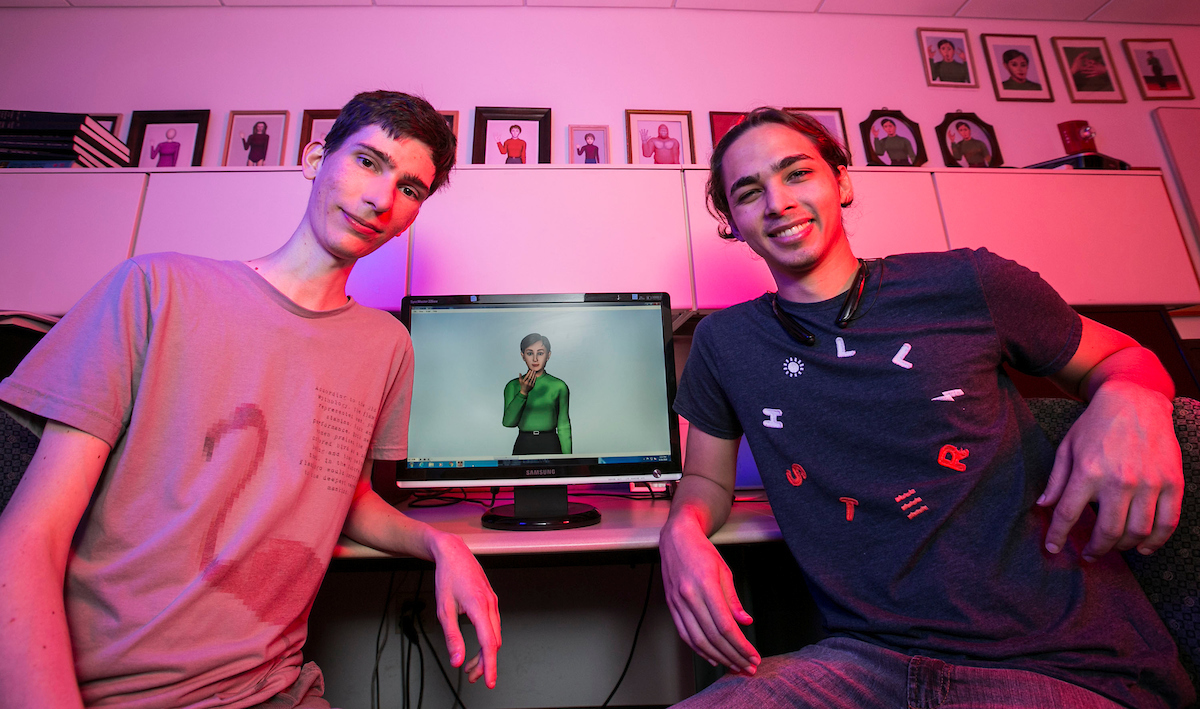 Visiting students Rodrigo De Nardin (left) and Rafael Senhorinho worked over the summer in the College of Computing and Digital Media to build a foundation of Brazilian Sign Language for DePaul's ASL Avatar Project, which translates typed words and phrases into signed language. (DePaul University/Jamie Moncrief)
Visiting students Rodrigo De Nardin (left) and Rafael Senhorinho worked over the summer in the College of Computing and Digital Media to build a foundation of Brazilian Sign Language for DePaul's ASL Avatar Project, which translates typed words and phrases into signed language. (DePaul University/Jamie Moncrief)
While many people across the globe were focused on the Olympic Games in Rio this summer, two Brazil natives were hard at work in the College of Computing and Digital Media. To close out their year studying abroad at DePaul through the Brazil Scientific Mobility Program, senior Rafael Senhorinho and junior Rodrigo de Nardin spent their final weeks at DePaul developing an alphabet and vocabulary for the Brazilian Sign Language branch of DePaul's larger American Sign Language Avatar Project.
Through this technology developed at DePaul, users are able to type words and phrases into the system, which will then be translated into American Sign Language by an avatar. Though Senhorinho, an animation student, and de Nardin, a visual design student, had no previous experience with any sign language before the internship, they played a key role in building the basic Portuguese foundation for the project, which will allow for translation into Brazilian Sign Language.
"This was a completely unique and compelling experience," Senhorinho says. "It's not something I ever could have imagined I'd work on. Not only will the technical skills help me in my final year of school back in Brazil, but I now have some knowledge of a new language that I can share with people at home."
 Paula, the ASL Avatar Project's avatar, signs the word 'azul,' which means blue, in Brazilian Sign Language. (DePaul University/Rosalee Wolfe)
Paula, the ASL Avatar Project's avatar, signs the word 'azul,' which means blue, in Brazilian Sign Language. (DePaul University/Rosalee Wolfe)
This fall, leaders of the project plan to run focus groups with Brazilian teachers of the deaf to evaluate the new branch of the project's technology viability for classroom use.
Since 2001, DePaul's ASL Avatar Project has worked to automatically translate English into American Sign Language. Contrary to common belief, American Sign Language is not simply English coded into non-verbal form; rather, it's an entirely different language. Signed languages utilize handshape, position, palm orientation and movement, and many phrases are displayed as one cue or gesture. The relationship between Brazil's national language, Portuguese, and Brazilian Sign Language mirrors that of English and American Sign Language, and thus shares a need for better translation.
"Around the world, deaf people have difficulty with both spoken and written language because their average reading skill is at or below the fourth-grade level," says Rosalee Wolfe, a professor in the School of Computing and cofounder of the project. "Software to translate written language into signed language would give deaf people better access to jobs, health care and social services."
Since the launch of the project, Wolfe and John McDonald, as associate professor in the School of Computing, have worked with both deaf and hearing students and faculty to develop software that goes beyond basic American Sign Language vocabulary to pose questions, make verbs agree in subject and object, and tell stories. The technology has already been used for sign language interpreter training and deaf education.
"We've been working on the ASL Avatar Project for more than a decade now, and wanted to incorporate other signed languages, such as Brazilian Sign Language, in hopes of making this concept accessible on a global scale," Wolfe says. "We're thrilled to be able to share these tools and resources beyond the barriers of our own language, and potentially make life better for deaf people."